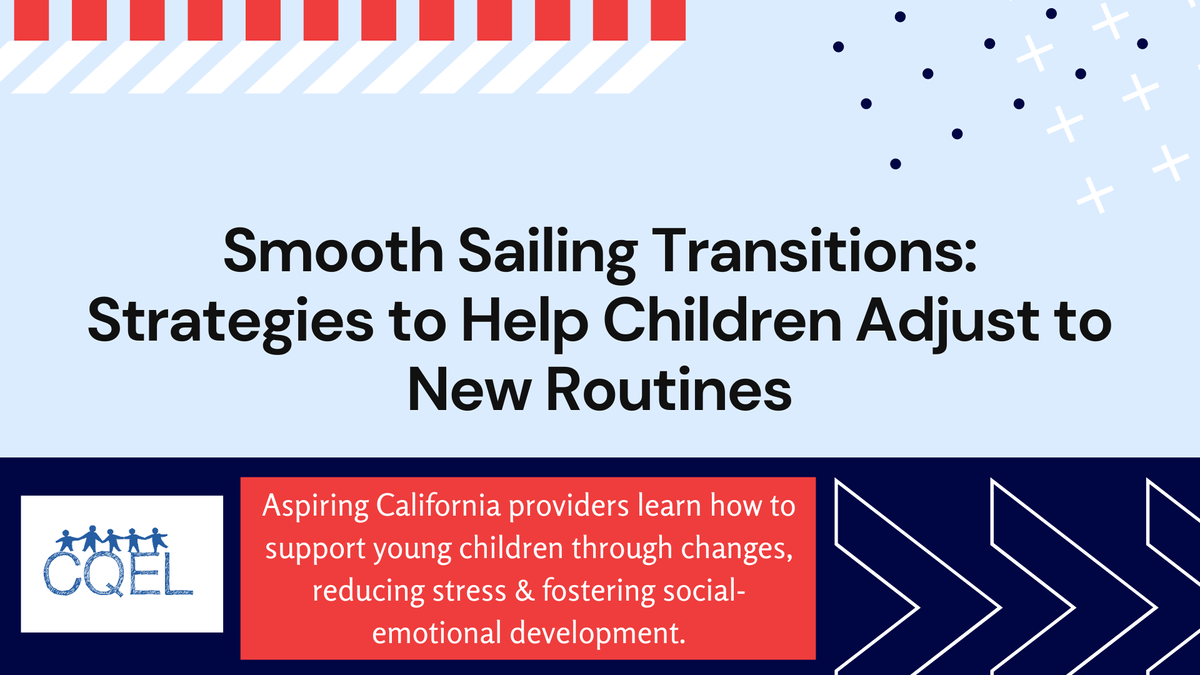Smooth Sailing Transitions: Strategies to Help Children Adjust to New Routines
Aspiring California providers, learn how to support young children through changes, reducing stress & fostering social-emotional development. Create a positive learning environment where all children feel secure & ready to explore!

New children join the program, schedules change, and room rotations happen. While these changes can be exciting, they can also be stressful for young children. As an aspiring childcare provider in California, understanding how to support children during transitions is crucial for fostering a sense of security and promoting their social-emotional development. Smooth transitions not only minimize stress but also contribute to a positive learning environment where children feel comfortable and ready to explore.
Transitions can encompass any change in a child's routine, environment, or expectations. Starting a new childcare program, transitioning to a new classroom within the program, or even a simple change in the daily schedule can trigger emotional challenges in children. These challenges can manifest as anxiety, fear of the unknown, or separation anxiety from familiar caregivers. It's important to remember that each child reacts differently to transitions. Some children may adapt quickly, while others may require more time and support.
The key to promoting smooth transitions lies in preparation, routines, and communication. Preparing children for upcoming changes in advance can significantly reduce anxiety. Utilizing social stories, which are short narratives depicting the transition in a positive light, or picture books with similar themes, can be effective tools. In some cases, arranging a visit to a new classroom before the first day allows children to familiarize themselves with the environment and feel more comfortable when the transition occurs.
Establishing consistent routines and predictable schedules provides a sense of security and stability for children. Knowing what to expect throughout the day helps them feel more in control and reduces anxiety during transitions. Whenever possible, strive for consistency between childcare routines and routines at home. This collaboration with parents ensures a unified approach to supporting children's social-emotional well-being.
Positive communication and reassurance are essential during transitions. Use calming language and validate children's feelings. Acknowledging their concerns and offering comfort and support demonstrates your understanding and helps them feel safe. Empowering children with a sense of control whenever possible can also be beneficial. This could involve offering choices about activities, seating arrangements, or how to approach a new situation with a new caregiver.
Remember, each child is unique. Tailor your transition support strategies to individual needs and temperaments. Some children may require more time, one-on-one attention, or specific comfort items (like a favorite blanket) to feel secure during transitions.
Collaboration with parents is another key element for promoting smooth transitions. Communicate openly with parents about routines and expectations at home, and share strategies used at childcare to support their child's adjustment. Working together ensures a consistent and supportive environment for children throughout their day.
By implementing these strategies, you can create a childcare setting where transitions are smooth and predictable, fostering a sense of security and promoting children's social-emotional well-being. Remember, supporting children during transitions is an ongoing process. Continuously seek new strategies and refine your approach to ensure all children feel comfortable, confident, and ready to learn in your care.
Additional Resources
- Zero to Three: Social-Emotional Development: https://www.zerotothree.org/
- National Association for the Education of Young Children: Social-Emotional Learning: https://www.naeyc.org/resources/topics/social-and-emotional-development
- Social Stories for Transitions: https://www.storyboardthat.com/education/learn-more-about-classroom-edition
